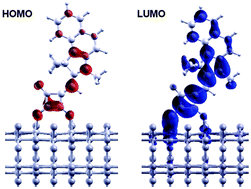Combined experimental and theoretical investigation of the hemi-squaraine/TiO2 interface for dye sensitized solar cells†
Abstract
A simple hemi-

* Corresponding authors
a
Dipartimento di Scienza Applicata e Tecnologia, Politecnico di Torino, Corso Duca degli Abruzzi 24, Turin, Italy
E-mail:
giancarlo.cicero@polito.it
Fax: 39 011 5647399
Tel: 39 011 5644659
b Dipartimento di Chimica and Nanostructured Interfaces and Surfaces Interdepartmental Center of Excellence Università degli Studi di Torino, Via Pietro Giuria 7, Turin, Italy
c Cyanine Technologies S.p.A and Pianeta s.r.l., Via Giannone 3, Settimo Torinese, Italy
d Center for Space Human Robotics @Polito, Istituto Italiano di Tecnologia, Corso Trento 21, IT-10129 Torino, Italy
e Dipartimento di Chimica Fisica e Inorganica, Università di Bologna Viale Risorgimento 4, IT-40136 Bologna, Italy
A simple hemi-

 Please wait while we load your content...
Something went wrong. Try again?
Please wait while we load your content...
Something went wrong. Try again?
G. Cicero, G. Musso, A. Lamberti, B. Camino, S. Bianco, D. Pugliese, F. Risplendi, A. Sacco, N. Shahzad, A. M. Ferrari, B. Ballarin, C. Barolo, E. Tresso and G. Caputo, Phys. Chem. Chem. Phys., 2013, 15, 7198 DOI: 10.1039/C3CP50559F
To request permission to reproduce material from this article, please go to the Copyright Clearance Center request page.
If you are an author contributing to an RSC publication, you do not need to request permission provided correct acknowledgement is given.
If you are the author of this article, you do not need to request permission to reproduce figures and diagrams provided correct acknowledgement is given. If you want to reproduce the whole article in a third-party publication (excluding your thesis/dissertation for which permission is not required) please go to the Copyright Clearance Center request page.
Read more about how to correctly acknowledge RSC content.
 Fetching data from CrossRef.
Fetching data from CrossRef.
This may take some time to load.
Loading related content
